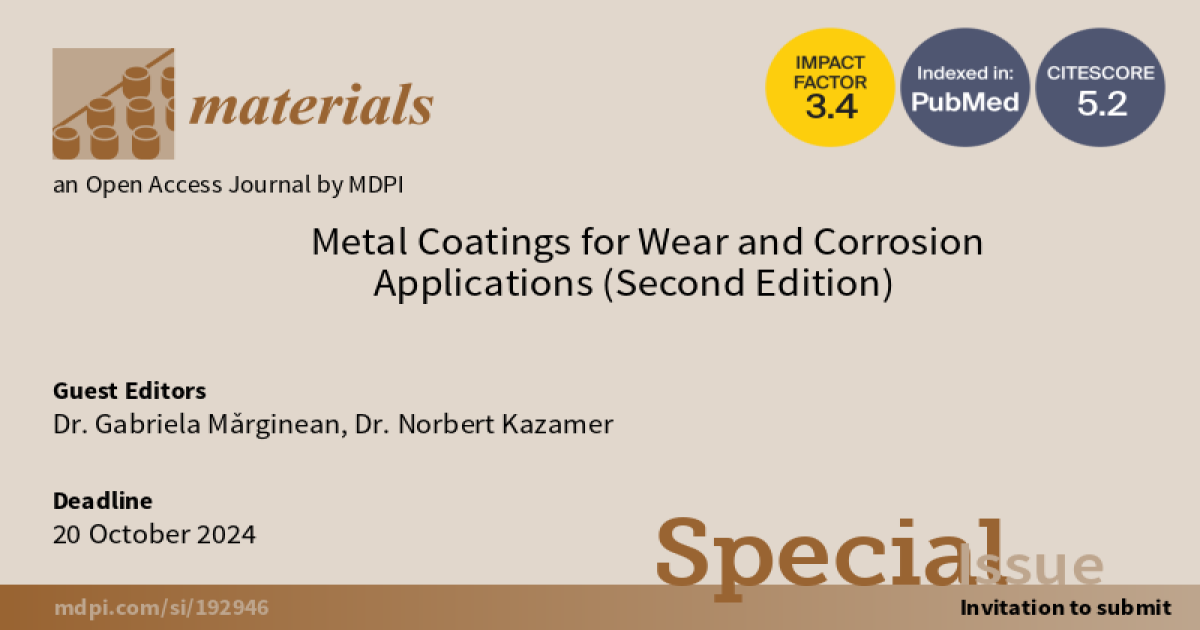Metal Coatings for Wear and Corrosion Applications (Second Edition)
A special issue of Materials (ISSN 1996-1944). This special issue belongs to the section "Thin Films and Interfaces".
Deadline for manuscript submissions: 20 October 2024 | Viewed by 1461

Special Issue Editors
Interests: thermal barrier coatings; self-fluxing alloys; marine corrosion; wear resistant cermets; additive manufacturing; PEM fuel cells
Special Issues, Collections and Topics in MDPI journals
Interests: self-fluxing alloys; coatings post-processing; optimization; wear resistant coatings; oxygen evolution reaction; PEM water electrolysis
Special Issues, Collections and Topics in MDPI journals
Special Issue Information
Dear Colleagues,
This Special Issue is dedicated to research activities concerning the wear and corrosion behaviour of metallic coating materials. Topics of interest may range from fundamental understandings of the wear of corrosion mechanisms to special solutions for their practical application. Materials are exposed to different types of wear (friction, abrasion, erosion) and corrosion attacks (chemical or electrochemical corrosion, molten salt corrosion, high-temperature corrosion), leading to severe material degradation. Therefore, our knowledge of surface engineering must be combined with fundamental information on materials science to understand the observed phenomena and prevent further failure.
In this context, submissions may tackle subjects as diverse as technologies for the deposition of metallic coatings, additive manufacturing methods, or the surface postprocessing of applied coatings using laser or electron beam sources. Functional gradient advanced materials as well as structured surfaces with special chemical, biological, optical, nuclear, aerospace, or other applications have been developed and applied in recent years, but some key problems still need to be elucidated and solved.
It is my pleasure to invite you to submit a manuscript for this Special Issue. Full papers, communications, and reviews are all welcome.
Dr. Gabriela Mǎrginean
Dr. Norbert Kazamer
Guest Editors
Manuscript Submission Information
Manuscripts should be submitted online at www.mdpi.com by registering and logging in to this website. Once you are registered, click here to go to the submission form. Manuscripts can be submitted until the deadline. All submissions that pass pre-check are peer-reviewed. Accepted papers will be published continuously in the journal (as soon as accepted) and will be listed together on the special issue website. Research articles, review articles as well as short communications are invited. For planned papers, a title and short abstract (about 100 words) can be sent to the Editorial Office for announcement on this website.
Submitted manuscripts should not have been published previously, nor be under consideration for publication elsewhere (except conference proceedings papers). All manuscripts are thoroughly refereed through a single-blind peer-review process. A guide for authors and other relevant information for submission of manuscripts is available on the Instructions for Authors page. Materials is an international peer-reviewed open access semimonthly journal published by MDPI.
Please visit the Instructions for Authors page before submitting a manuscript. The Article Processing Charge (APC) for publication in this open access journal is 2600 CHF (Swiss Francs). Submitted papers should be well formatted and use good English. Authors may use MDPI's English editing service prior to publication or during author revisions.
Keywords
- coatings
- aqueous corrosion
- high-temperature corrosion
- sliding wear
- abrasion
- solid particle erosion
- additive manufacturing
- electron beam remelting
- laser structuring







